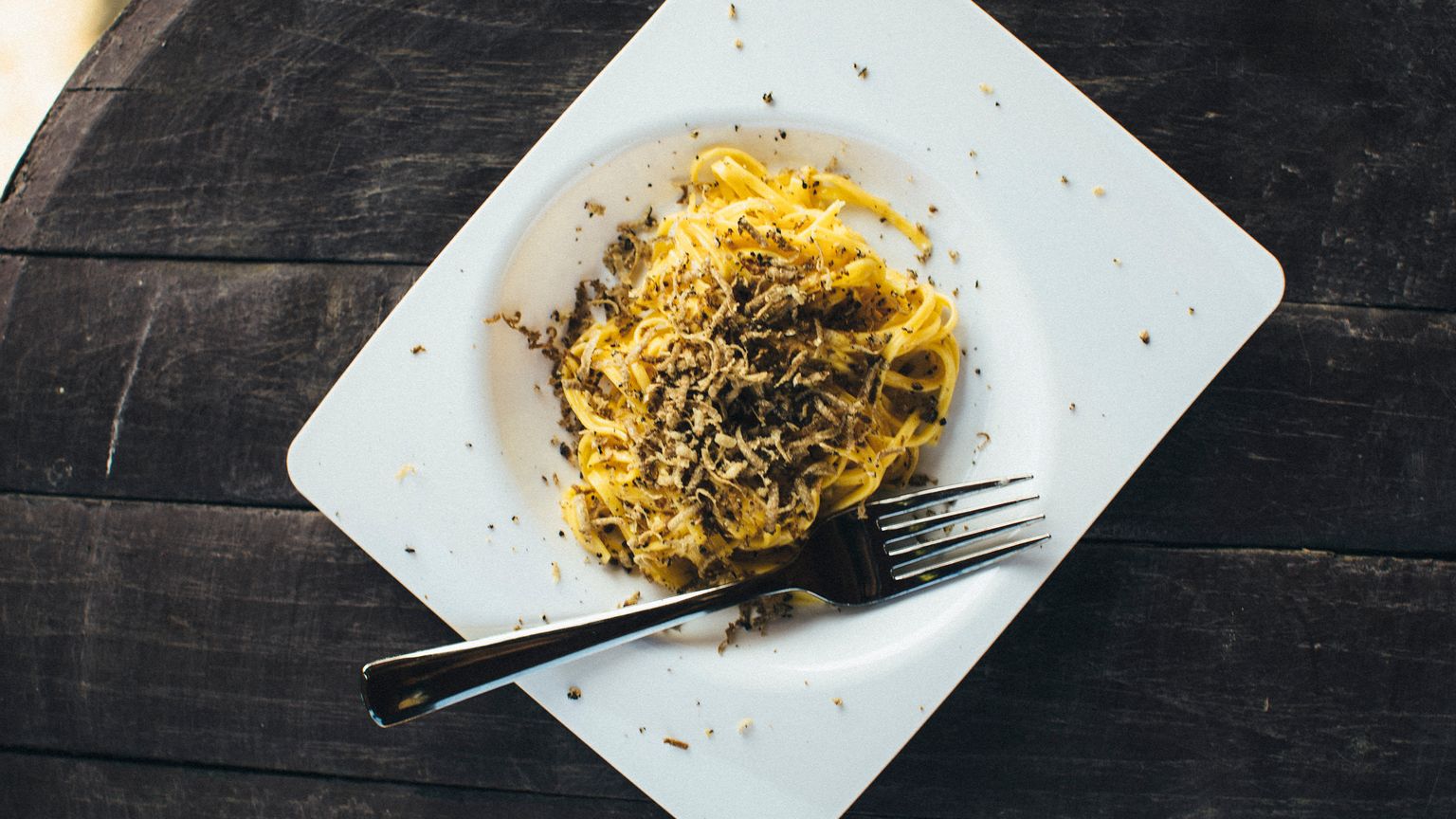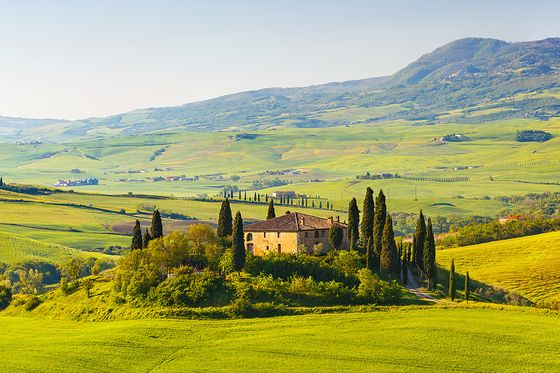)
A guide to truffle hunting in Italy
Dreaming of hunting for Italian truffles? See where to find rare Alba white truffles, how to find the freshest Tuscan black truffles, and the top Italy truffle hunting tours to take you there.
Truffle hunting in Italy is one of those rare, bucket list experiences that blends food, tradition, and adventure in a way only Italy can. When wandering through misty forests alongside expert hunters and their dogs on our Food & Wine: Northern Italy & the Italian Riviera tour, you’ll get a firsthand look at the rich history behind Italian truffles—a culinary treasure prized for centuries. Or, dive even deeper into the Italian truffle food scene on our Food & Wine: Piedmont & Tuscany with America’s Test Kitchen tour, where you’ll get to attend the annual Alba White Truffle Fair.
In this guide, you’ll discover where to find the country’s most celebrated truffle regions, when each variety is in season, how generations of families have perfected the hunt, and why these elusive white and black gems are among the world’s most sought-after ingredients. Consider this your inside look at everything that makes truffle hunting in Italy unforgettable.

What are truffles?
Truffles are a type of fungi belonging to the tuber genus, prized for their intense aroma and rich, earthy flavor. Unlike mushrooms that grow above ground, truffles develop completely underground, which contributes to their unique texture and depth of taste.
Where are truffles found?
They grow beneath the soil at the roots of certain trees—most often oak, hazelnut, and beech. Because they’re hidden from sight, truffle hunters rely on specially trained dogs to sniff out their distinct scent and uncover them without damaging the delicate fungi.
Why are truffles so expensive?
Truffles are costly because they’re rare, difficult to find, and limited to very specific growing conditions. Their short, unpredictable seasons and the skill required to harvest them add to their value, making each truffle a highly sought-after culinary treasure.

What does truffle hunting in Italy entail?
If you’re still wondering, “What is truffle hunting?”, it’s the time-honored practice of using highly trained dogs to locate these aromatic fungi hidden beneath the forest floor. Truffle hunting in Italy is especially renowned, blending tradition, skill, and an expert bond between hunter and dog. During an Italian truffle hunt, dogs with exceptional senses of smell—often able to detect a truffle from incredible distances—lead the way. Their owners, licensed and allowed to work only during designated seasons, follow closely as the dogs pinpoint the exact spot. From there, the hunter uses a small hoe, called a zappino, to gently unearth the truffle without damaging it or the surrounding soil. This careful method is essential; hunting truffles depends on preserving the delicate root systems that allow future truffles to grow, ensuring this centuries-old Italian tradition continues for generations.

Where to go truffle hunting in Italy
Two top Italian truffle hunting destinations stand out: Piedmont and Tuscany. Alba truffle hunting is world-famous, especially during the International Alba White Truffle Fair each fall. (And psst! Our Food & Wine: Piedmont & Tuscany with America’s Test Kitchen tour takes you straight to the heart of this culinary celebration.) For those interested in Florence truffle hunting, our Food & Wine: Northern Italy & the Italian Riviera tour pairs authentic experiences with incredible local cuisine, like tagliolini al tartufo nero, a delicious pasta dish topped with black truffle. Both of these tours will take you truffle hunting in Tuscany, where you’ll explore stunning landscapes, hunt alongside expert dogs, and savor the freshest truffle dishes straight from the source.
Truffle hunting tours

When is truffle season in Italy?
While truffles grow year-round, truffle season is regulated in Italy to protect the delicate ecosystem. Truffle hunting is prohibited in May and from September 1-20 each year. The timing of truffle season varies by type: the famous white truffle season in Alba runs from late September to late January, making fall and early winter prime months for this prized delicacy. Black truffle season typically spans the beginning of December through mid-March. Other varieties, like summer and winter truffles, have their own specific windows throughout the year. So, planning your trip around these seasons ensures the best chance to experience authentic truffle hunting and enjoy fresh, seasonal Italian truffles at their peak.
Here’s an approximate breakdown of when each prized fungi is ripe for the finding.
- Alba white truffle season runs from late September to late January.
- Black truffle season runs from early December to mid-March.
- Summer truffle season runs from early June to late August.
- Winter truffle season runs from late December to mid-March.
- “Whitish” (Bianchetto) truffle season runs from late January to early April.

Where do truffles come from?
If you’re curious about where truffles are found, the answer lies in a special symbiotic relationship with certain trees. Specifically, where truffles grow in Italy depends on this delicate balance—truffles attach to the roots of trees like oak, hazelnut, and beech, and exchange nutrients helping each other thrive. This partnership allows the truffles to develop underground, producing the fruiting body that hunters seek.
When searching for truffles, expert dogs are trained to detect the scent of these fungi as they mature. Knowing where to find truffles means understanding this natural cycle, because truffles only fully develop their prized aroma and size in the final days before harvest, making truffle hunting in Italy a unique and exciting adventure.

Types of Italian truffles
Italian truffles are a prized delicacy, with two main types dominating the culinary scene: white truffles and black truffles. Among the many varieties found worldwide, Italy boasts 25 species of wild-growing truffles, but only nine are safe to eat. Of these, six are especially celebrated in Italian cuisine. The most famous are the Piedmont white truffle and the Italian black truffles, both iconic to their regions. The Alba white truffles are especially renowned for their intense aroma and rarity, making them prized finds during truffle season. Other varieties of Italian truffles, like summer, winter, and “whitish,” offer unique flavors, but the white and black truffles reign supreme as the king and queen of Italy’s truffle family.

What’s the difference between a white truffle and a black truffle?
When comparing white truffles and black truffles, the differences come down to aroma, flavor, and how each is used in the kitchen. If you’re wondering, “What do truffles taste like?”, that depends largely on which kind you’re eating—especially when it comes to white truffles in Italy, which are prized more for their scent than their flavor. In a nutshell, white truffles have a much stronger smell but a milder taste. The opposite is true for black truffles.
Here’s a snapshot of what makes white and black truffles unique.
Alba white truffles
White truffles are intensely aromatic, delicately flavored, and exceptionally rare—Alba white truffles are one of the most luxurious and expensive truffles in the world.
Aroma: White truffles are famous for their powerful, layered aroma, which is why white truffles from Alba, Italy, are so highly valued. “If you pay attention when you smell white truffles, you can catch some different aromas like garlic, honey, and hay,” said truffle hunting expert Natale. “It’s really a symphony of perfumes. The quality of the truffle depends on the balance of the aromas.”
Taste: Despite the strong smell, the flavor is subtle and refined. The experience comes from the aroma moving from the mouth to the nose rather than a bold taste on the palate.
Price: White truffles are by far the most expensive truffles on the market, often costing between €250 and €800 for 100 grams. This being said, pricing varies greatly year to year. “Normally at a restaurant, they shave 8-10 grams per person,” said Natale.
Location: White truffles are most commonly found in the Piedmont region near the city of Alba.
Appearance: The exterior of this truffle is a faint yellow color, while the interior features intricate white veining.
Growing conditions: White truffles only grow in the wild, which makes it even more rare in the truffle world. These rarities prefer to grow in shady areas close to water that sit below an elevation of 2,300 feet.
Black truffles
Earthy, flavorful, and more versatile—this truffle shines when cooked and is far more accessible than its white counterpart.
- Aroma: Black truffles have a milder, straightforward scent with notes of mushroom and wood.
- Taste: Black truffles have less aroma, but a richer and more pronounced flavor than white truffles, making them ideal for cooking into sauces, pastas, and oils.
- Price: Black truffles more affordable than white truffles. Again the pricing can vary tremendously, but you can expect to pay between €35 and €60 per 100 grams. “100 grams of truffle are enough for 10-12 people,” said Natale.
- Location: Black truffles are harvested across Spain, France, and Italy, with strong growing regions in Piedmont and Tuscany.
- Appearance: No surprise here, the namesake of this truffle comes from its black-hued exterior. But once you cut into a black truffle, the inside has a faint, light-colored veining.
- Growing conditions: Unlike wildly growing white truffles, black truffles can be cultivated, often farmed on sunny hillsides with widely spaced trees.

How to store truffles
Storing truffles properly is essential if you want to preserve their aroma, texture, and flavor for as long as possible. According to truffle expert Natale, the process is simple but precise: Truffles should be wrapped loosely in a clean, dry paper napkin, then placed inside a sealed glass jar and stored in the refrigerator. The ideal temperature range is between 37.4 and 42.8 F, cold enough to slow spoilage without damaging the truffle. It’s crucial to replace the paper napkin every day, as truffles naturally release moisture. If that moisture builds up, it can cause the truffle to soften, ferment, or spoil. Keeping the truffle dry is the key to maintaining its quality, ensuring that when you’re ready to shave it over pasta or risotto, it still delivers the signature aroma and flavor that make truffles so prized.

What do truffles taste like?
So, what do truffles taste like? It depends on the variety, but truffles are known for their deep, earthy, and savory flavor that enhances a dish without overpowering it. White truffles are prized for their intense aroma—garlicky, slightly sweet, and almost floral—which is why they’re always shaved raw. On our Food & Wine: Piedmont & Tuscany with America’s Test Kitchen tour, you’ll experience them atop fresh, egg-based pastas like tagliatelle, tagliolini, or stuffed pastas such as ravioli and agnolotti, where the warmth of the dish releases their fragrance.
Black truffles have a milder scent but a richer, more robust flavor, making them ideal for cooking. You’ll find them worked into sauces, served over roasted meats and vegetables, or folded into pasta dishes on our Food & Wine: Northern Italy & the Italian Riviera tour. Truffle expert Natale even recommends infusing eggs with truffle aroma before cooking for next-level pasta. However they’re served, every bite will be memorable. Experience it yourself on a true Italian truffle tasting tour with us.









)









)















































































